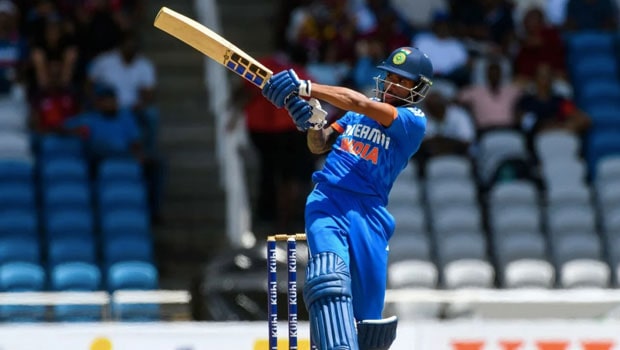What appeared to be five drab T20Is in an ODI World Cup year ended up being potentially defining for India’s squad for the biggest event of the year, starting October 5, as several key and fringe players put in contrasting performances across the series. Where the likes of Tilak Varma and Yashasvi Jaiswal, who both made their T20I debuts in the West Indies, produced some attractive innings that raised decibel levels about their ODI selection, players such as Sanju Samson fluffed their lines and Hardik Pandya’s captaincy raised eyebrows multiple times.
India, ranked No 1 in T20Is, were expected to boss this series but instead ended up losing to West Indies for the first time since 2016.
India’s experiments in the preceding three ODIs – a shockingly poor batting rejig in the first, when chasing just 115, followed by Rohit Sharma and Virat Kohli sitting out the next two games – turned the tone of these five T20Is versus West Indies, and once the series started the interest piqued because many watchers wanted to see what the next blunder would be.
As it panned out, narrow defeats in the first two T20Is – by four runs and two wickets respectively – left Pandya’s team needing to win the next three to avoid a first bilateral series defeat to West Indies since 2016. They ticked off one of those in the third match at Providence, during which Suryakumar Yadav struck form after a lean patch and Kuldeep Yadav picked up his best figures in the format since the previous tour to the Caribbean in 2022. Then the bandwagon shifted to Florida, where the

The fourth match saw West Indies set India a target of 179, which from a scoreline of 57 for 4 indicates how Pandya allowed the ‘home team’ to get too many, but those runs were comfortably chased down thanks to an opening stand of 165 between Jaiswal and Shubman Gill.
Having levelled the series at 2-2, India came undone in the decider. They lost wickets to stumble to 165 in 20 overs, with Suryakumar hitting another half-century, but the bowling was run ragged as Brandon King (85* from 55) and Nicholas Pooran (47 off 35) dominated.
THE GOOD
The standout performer for India was 20-year-old Tilak Varma, who marked his maiden outing with 173 runs at an average of 57.66 and strike-rate of 140.65. So dominant was the left-hander’s batting across these five T20Is that midway during the series calls arose for him to be fast-tracked into the ODI team for the Asia Cup, with an eye on the World Cup starting October 5.
On international debut, Varma top-scored for India with 39 from 22 balls out of a total of 145; in the next game he made 51 off 41 deliveries, again the best score for his team; then he finished 49* off
37 as India aced a chase of 160.
After a lean run in the ODIs, Suryakumar hit some form in the last two T20Is to finish the series with 166 runs at 41.50 with a strike-rate of 146.90. Arshdeep Singh’s first appearance for India since February 1 was a welcome return, given how vital he is for their T20 World Cup plans. Not considered for ODIs, Arshdeep slotted back for the T20I series and claimed the most wickets for India (seven) though an economy of 9.17 was bruising.
THE BAD
Gill’s inconsistent form since a barnstorming IPL season for Gujarat Titans continued across formats on the tour of the West Indies. Just 60 runs in two Tests and 126 from three ODIs was followed by 102 in the T20Is.
Gill failed to get to double digits in the first three T20Is and then in Florida, where batting conditions were far better, he smacked five sixes and three fours in getting 77 off 47 deliveries. Does this suggest that Gill has serious problems away from the featherbeds of India, and in particular Ahmedabad where he has flourished in 2023? Not entirely, but there is definitely a problem in his batting on sluggish, two-paced tracks based on his struggles in the Tests, ODIs and T20Is in the West Indies.
Pandya made some odd selection calls and stranger decisions on the field, and was very under-par as the key allrounder he is supposed to be in this team. Just 77 runs in four innings and four wickets did not help India’s cause. But more alarming were his bowling changes, the dependency on pacers in the latter half of matches and some poor Powerplay decisions in regards to spinners. What added to muddled picture were some of Pandya’s post-match statements.
Ishan Kishan was Player of the Series in India’s 2-1 win in the ODI leg of their tour, but after two scratchy innings in the T20Is he sat out the rest of the series.
THE UGLY
Samson kept wickets in the last three matches and batted thrice in five matches, managing just 32 runs, so it seems he might be a part of India’s World Cup plans given the progress that KL Rahul is apparently making.
Mukesh Kumar was played across all five matches, and given a lot of faith in the death overs, but he managed just three wickets while conceding runs at 8.80 per over. Axar Patel was bowled for just 11 overs in five matches, and took two wickets with an economy of 8.45.



























